After the conclusion of the 2 degrees expedition, Bernice Notenboom was motivated to take one step further by giving a real, up-front and personal experience to communicate the effects of climate change and encourage industry to move towards carbon neutral solutions and sustainability.
CEOs and top managers from various Dutch industries such as Schiphol Airport, Gasunie, NS, ING Bank, and Rotterdam Harbour (Havenbedrijf) were invited to participate in a four-day sailing trip north of the Arctic Circle around Svalbard to witness the effects of climate warming with their own eyes. The objective was to convince these companies to make concrete plans whilst on board, in order to seek sustainable business solutions and to collectively contribute to achieving the 2 degrees goal of the Paris Climate Agreement.
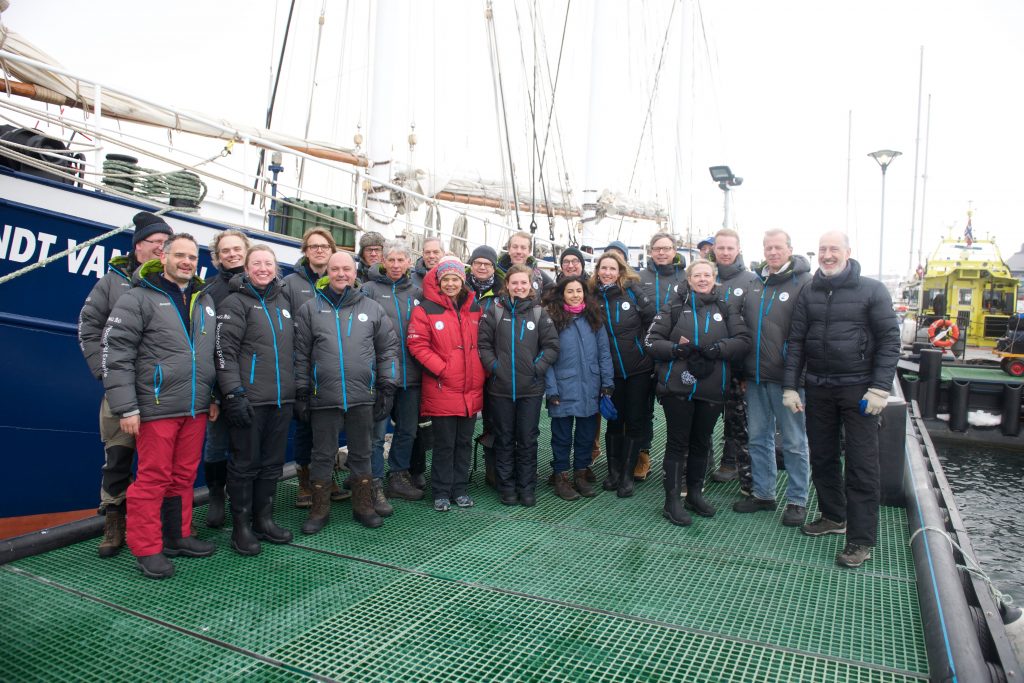
Top managers of Dutch businesses accompanied by Bernice (red jacket) and Mark Drinkwater of ESA (far right). (Martin Hartley)
I was invited, on behalf of ESA, to accompany Bernice and the top managers on the trip on the sailing vessel Rembrandt van Rijn to give lectures on the effects of Arctic climate change. In addition I supported a visit to the KSAT satellite receiving station to understand the role of ESA satellites and the Copernicus Sentinels in supporting Arctic climate change research, EU Arctic Policy and other beneficial applications of the data.
Arrival in Svalbard
Our first visual contact with Svalbard was on the long flight leg from Tromsø north across the Arctic Circle to Longyearbyen. The first spectacular aerial view of the changing icescape was of the surging glacier Morsnevbreen.
Many glaciers in Svalbard are surging at present, as determined from glacier movement detected from pairs of radar images collected routinely by the Sentinel-1A and -1B satellites.
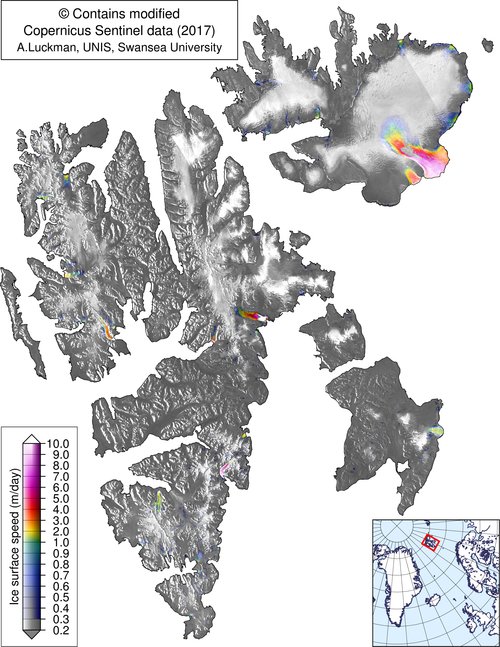
Svalbard surging glaciers. (A. Luckman UNIS, Swansea University)
The view of the glaciers and fjords gave the participants their first view of the Svalbard icescape, before arriving at Longyearbyen Airport.
Sailing to Kongsfjorden
Immediately upon arrival in Longyearbyen we boarded the three-mast ship Rembrandt van Rijn and set sail around the western coast of Svalbard towards Kongsfjorden ‘Kings Bay’.
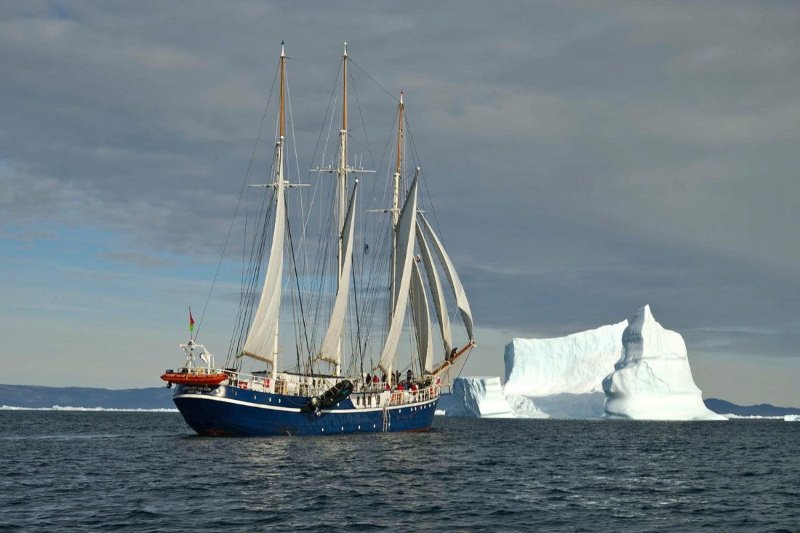
Rembrandt van Rijn under sail. (Oceanwide Expeditions)
14th July Glacier
Early in the morning on Sunday 30 April, we arrived at our first destination to make a spectacular hike to the mouth of the 14th of July Glacier. The glacier has quite a dramatic snout accessible from the shoreline – with deep blue ice spires breaking off the glacier front into the fjord. Thousands of rounded Icebergs were floating around in the bay. But everywhere there is evidence of melting, with long icicles suspended from every overhanging block of ice.
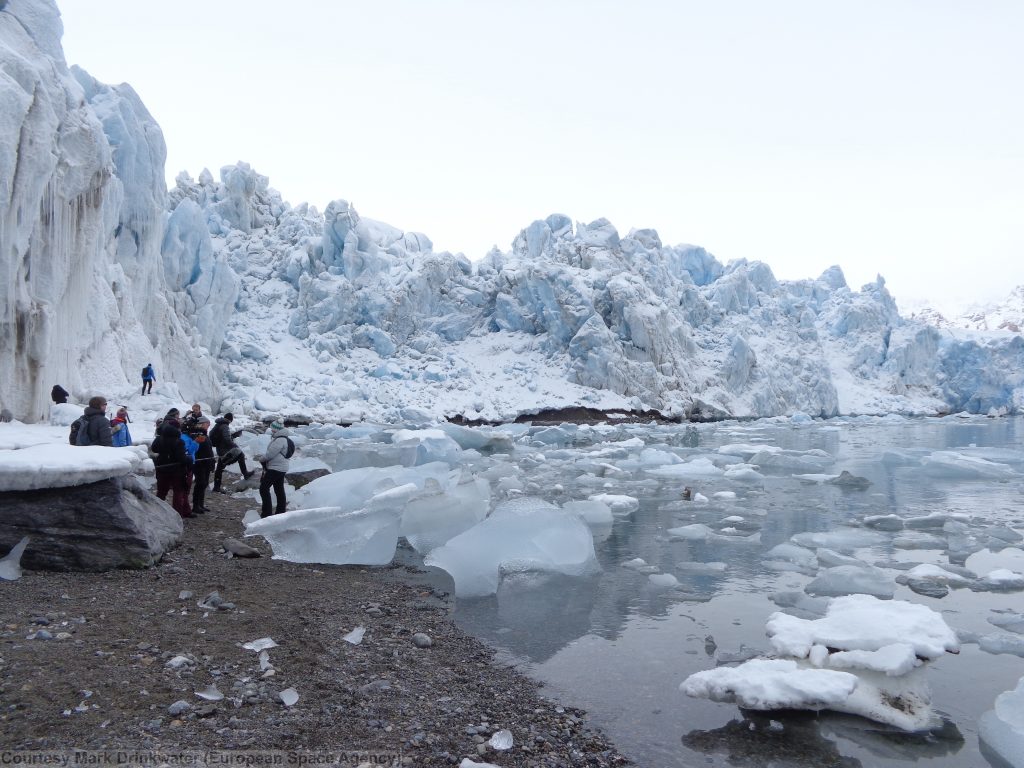
14th July Glacier, Svalbard. (ESA–M. Drinkwater)
Upon landing at the beach, I gave a talk about climate change impacts in the Arctic, including the observed widespread glacier recession in Svalbard, including that of the 14th July Glacier. The ‘Atlantification’ of the Arctic is resulting in warm water penetrating the fjords and mixing with the cold surface water, preventing sea ice from forming. Meanwhile the glacier ice spilling into the bay had quite an impact on the visitors, as well as the fragile beauty of the glaciated landscape.
As you walk along the beach you can see the recent retreat of the glacier, with the ice hollowed out by tides and melt erosion around the base of the ice wall.
Ny Ålesund
On the Sunday afternoon, the ship sailed into Ny Ålesund where we could look around the international research station and meet Norwegian colleagues from the Norsk Polarinstitut making glacier mass balance measurements on the local glaciers.
Maarten Loonen of University of Groningen gave us a tour of the research base explaining what kind of science is conducted, and explained his own field research of Canadian Geese. Unfortunately, the first geese are already spotted arriving, Maarten expressed concern that there is little for them to eat because of the unseasonal rains in February, which have transformed the surface of the snow layer into ice.
Situated at 78º 55′ N, Ny-Ålesund is one of the world’s northernmost year-round communities. Coal mining was the original reason for this remote settlement, but mining was put to an end after a serious accident in 1962. There are numerous cultural remains of technical, industrial, and exploration importance. For example, Ny-Ålesund was the starting point of several historical attempts to reach the North Pole, including the successful crossing of the pole in 1926 by the airship Norge by its designer Roald Amundsen, American explorer Lincoln Ellsworth and Italian pilot Umberto Nobile. A statue of Roald Amundsen can be found in the centre of the village.
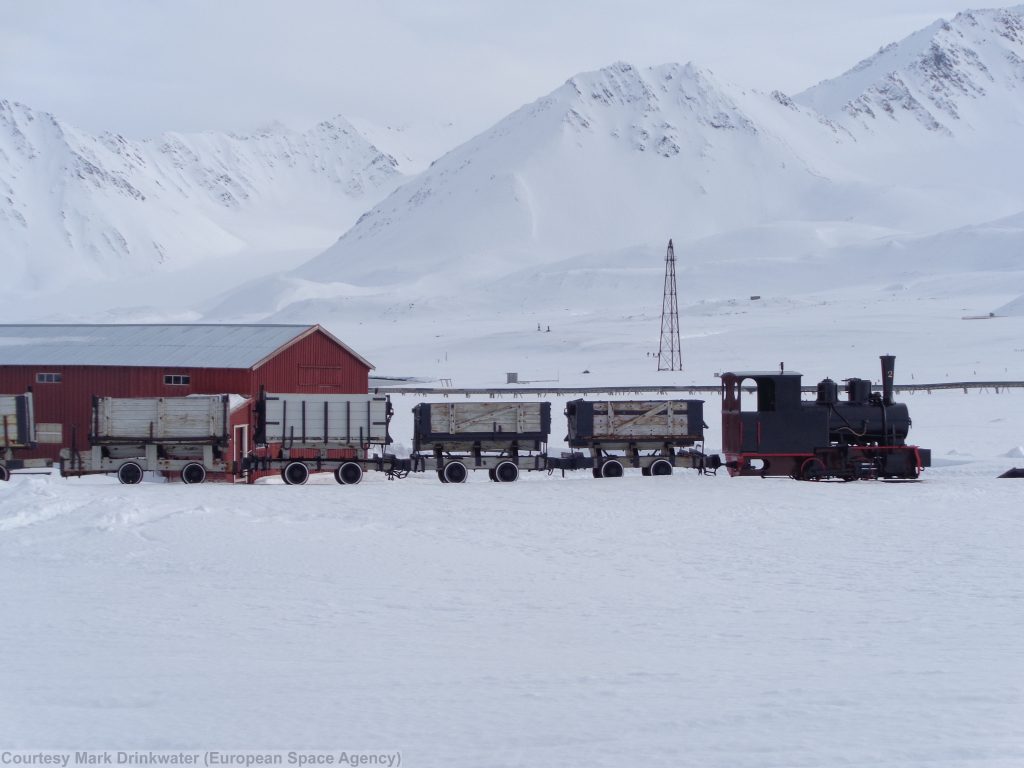
Time stood still: old steam train and the original airship mast in the background. (ESA–M. Drinkwater)
Time seems to have stood still in Ny-Ålesund since the days when large airships/Zeppelins explored the polar regions and since the Kings Bay coal mines were closed to make way for a research station. The Auroral Observatory in Tromsø established a branch there in 1966, and shortly after the European Space Research Organisation (ESRO) – predecessor of the European Space Agency (ESA) followed in 1967 with the opening of the Kongsfjord Telemetry Station used to communicate with ESRO satellites.
The place was re-established in the form of an Arctic research station when the Norwegian Polar Institute initiated permanent research in 1968. Since then, Ny-Ålesund has been a centre for international Arctic research and environmental monitoring. Today, a number of countries run their own national research stations here and research activity is high in the summer.
Blomstrandbreen
On the Monday morning, we sailed across Kongsfjord between Blomstrandhalvøya and the shoreline to visit Blomstrandbreen glacier. Although sea ice and some fast ice remained in the bay, the ship was able to anchor safely to be able to make a shore visit.
We used snow shoes to walk around the coastline to view the glacier front. Radical changes in the glacier front have taken place in the last 100 years, with dramatic recession evident in the comparison between recent photographs and ones taken in the 20th century (see https://www.svalbard-images.com/spitsbergen/global-warming-e.php).

Blomstrandbreen in May 2017, with sea ice in the fjord. (ESA–M. Drinkwater)
Visiting KSAT
Arrival back in Longyearbyen on Tuesday morning provided an opportunity to accompany two groups to visit the SvalSat facility run by Kongsberg Satellite. At the Ground Station, Manager Ole Petter Storstad and Marketing Director Nina Soleng presented the strategic importance of this particular satellite station at 78°N. The Longyearbyen KSAT facility is able to download and distribute data from an impressive portfolio of satellites, and in a matter of minutes provide important information to end users all over the world thanks to the fibre optic cable to the mainland. Both gave some great insights into the different application areas, along with examples of how ESA satellite data are being used to operationally monitor the environment.
In addition, I could explain to the partners how KSAT´s role was crucial for getting the updated ice information to Bernice and her team as they were heading to the North Pole. From time to time during the visit, the antenna would start to move and track as the Sentinel-1 satellite was passing over the pole, creating a lot of enthusiasm within the group.
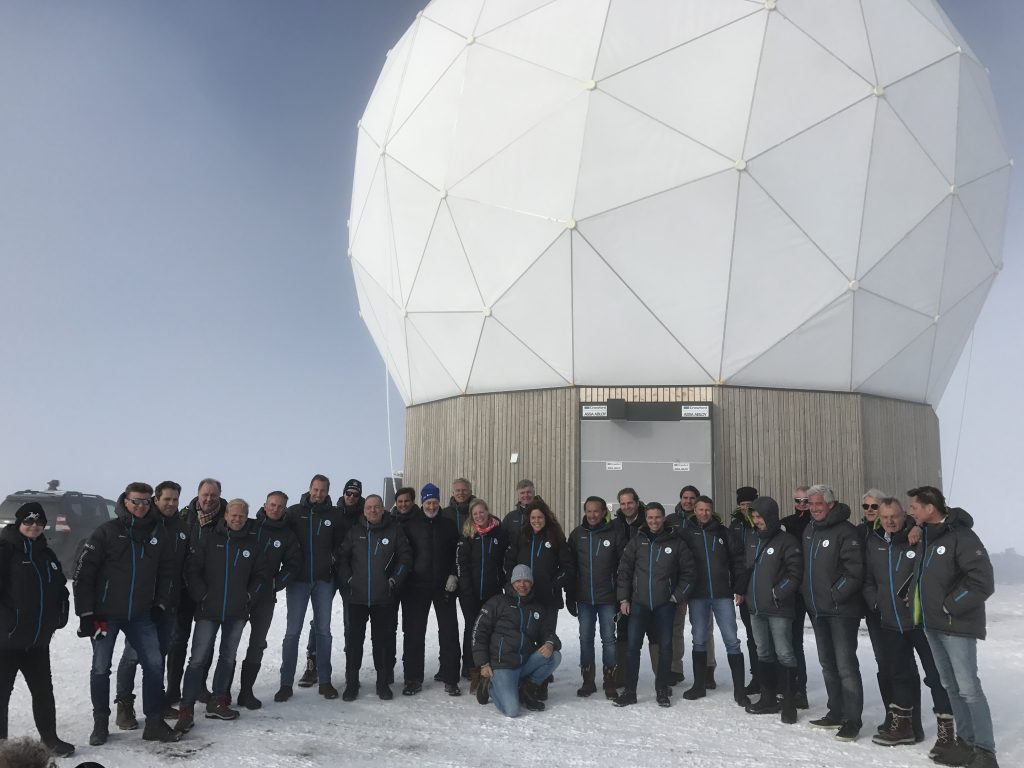
KSAT Sentinel-1 antenna at SvalSat in Longyearbyen, Svalbard. (Martin Hartley)
As a core ground segment provider to the Sentinels, KSAT downloads data from Sentinel-1 on the antenna inside the building where the visit took place. From these Sentinel data, I supported Henk-Jan Geel, Bernice’s Basecamp manager, in producing daily updated ice charts and drift forecasts for planning and making adjustments to the expedition route of the 2 degrees team.
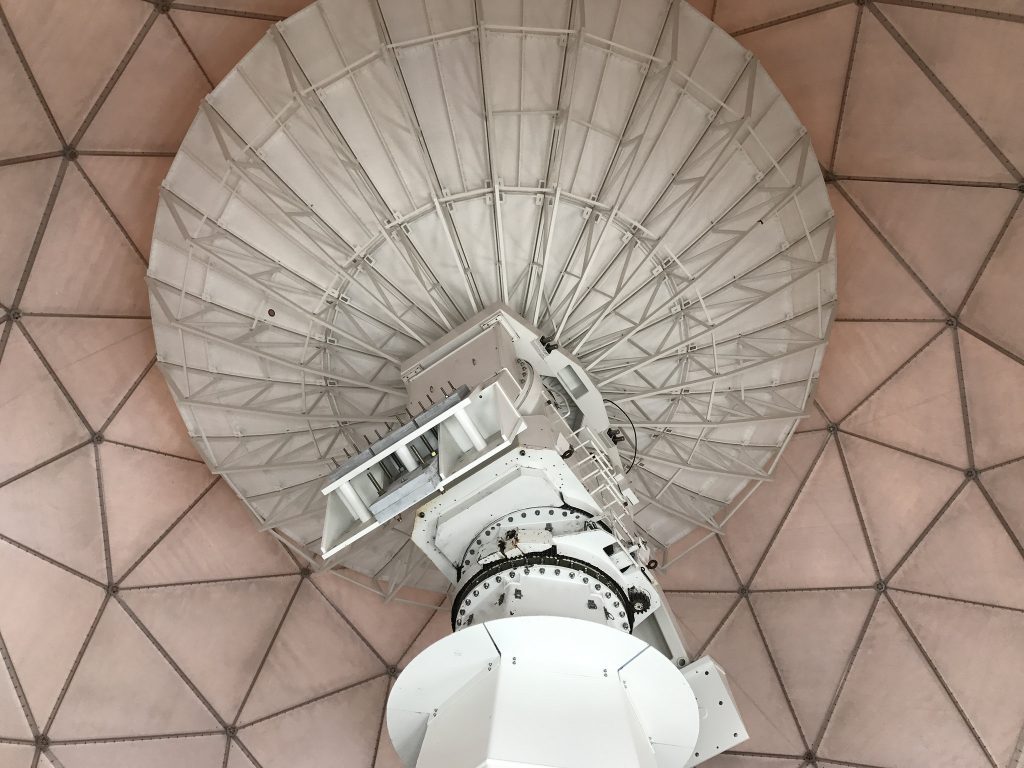
Sentinel-1_antenna. (Martin Hartley)
So What? What are the CEO’s going to do now?
After each day witnessing the rapidly transforming icy landscape of Svalbard, intense evening discussions were held in the galley. These discussions were intentionally focused around topics on sustainability and how NL businesses can implement more sustainable business practices to limit global warming to less than 2 degrees.
There’s no doubt that the journey on board the sailing vessel made a lasting impression on each of the participants. Many related in their own words the sensitivity of the Arctic region, and of the dramatic retreat of the sea ice and glaciers.
Here’s what some of the participants had to say:
Energy efficiency
“The speed with which the ice is disappearing has really affected me, and I am genuinely concerned about what I have seen,” said Carola Wijdoogen, Director of Sustainability, The Netherlands National Railway
Of all the participants, the NS is today perhaps the ‘cleanest’ of the companies involved: since the beginning of this year all trains are being powered by wind energy. Nonetheless, within the NS moves are being made to make the business more sustainable.
“We’re also involved with a project whereby the separation and recycling of waste allows NS to be even more energy efficient in the future”.
Towards Sustainability
Schiphol Airport has a number of plans underway to allow their operations to become more sustainable. These include, for example, use of as many sustainable materials as possible. Peter van Grinsven Director of Corporate Development at Royal Schiphol Group does not expect the current trend towards increasing flight traffic to change over the foreseeable future. “An ever-increasing number of people are flying and the growth is anticipated to continue. In this sector it is more important than ever to seek solutions by which we can facilitate growth to take place in a responsible and sustainable manner,” he said.
Also, ING are concerned that buildings become more sustainable by convincing companies of the need to take property with A, B or C energy efficiency labels. “And if the companies don’t take this step, then soon they will no longer receive financing,” said Leon Wijnands, Global Head of Sustainability at ING.
Rotterdam Harbour plans to implement new opportunities for ships to fill up with clean fuel and provide bonuses for companies that take this opportunity. “We are currently working hard with other companies to make concrete project plans to decarbonise and make the port more sustainable,” said Allard Castelein, CEO of Rotterdam Harbour (Havenbedrijf). “Also we want to deliver the heat produced by industrial processes in the Harbour to local residential areas and companies, and to make processing more sustainable by burning more biomass.”
The Gasunie also pledged to take steps towards become greener. “We’re adapting ourselves into a company for transporting energy to customers,” said Director Ulco Vermeulen. “Thus, no longer only natural gas, but also hydrogen and carbon dioxide. There are many approaches to eventually to remove dependency on tradition fossil fuels, and we intend to play a significant role in this transition to sustainable energy. If you wish to restrict warming of the Earth to less than 2 degrees, then above all you need to react fast. We need to implement measures that are effective but affordable.”
Need for government action
All participants indicated that they also expect something from the Dutch government. “The Government must sketch out the long-term framework for taking such sustainability measures, otherwise companies will not invest,” says Allard Castelein.
“Businesses want that a climate law is established soon, laying out clear, long-term goals. As this is not an issue of one period of government, but requires a 10, 20, and 30 year timescale,” says Ulco Vermeulen.
Post from: Mark Drinkwater (ESA)








Discussion: no comments